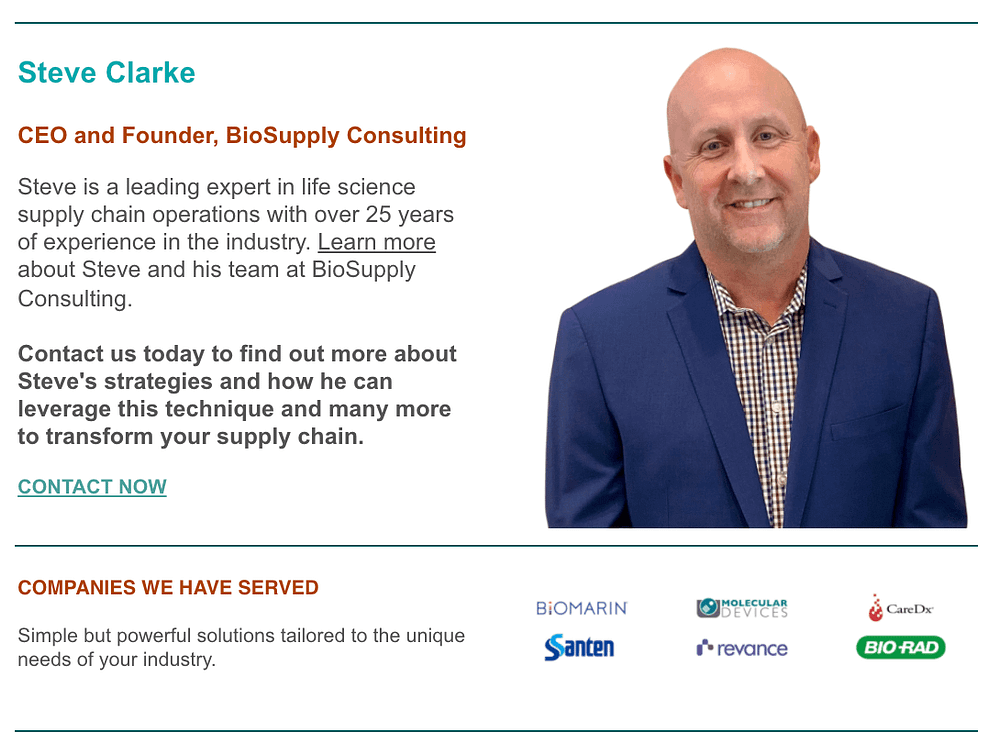LIFE SCIENCE SUPPLY CHAIN SOLUTIONS BY STEVE CLARKE
Challenge
I’m sure that your daily life as a supply chain leader is often chaotic and full of complexity. I know, I have also been living it for over 25 years – I had a full head of hair when I started. In this environment it can be very challenging to take a step back, and think about achieving strategic objectives, and continuous improvement of your operations. Your day is all about “putting out fires” not preventing them. Wouldn’t it be helpful to have an uncomplicated, easy to learn method to figure out which projects would have the largest impact on your supply chain objectives, and easily measure current performance and monitor progress over time. Unlike many solutions out there, it can be implemented immediately and it will enable sustained success over the long run. You don’t need an ERP system, control towers or fancy looking electronic dashboards. However, I would suggest investing in a white board, post-it notes and sharpies, if you don’t already have them.
Solution
There is one tool that can cut through all this complexity – metrics. However, not just any metric, and not 100 random metrics, but ones that are tied to strategic objectives. For a supply chain, selecting a strategic objective should not be too difficult. Generally, when all is said and done, your supply chain should profitably deliver the perfect order to your customers. That’s it! Every activity performed within your supply chain organization is to meet this goal. All the other metrics should measure how they are contributing to this overarching goal..In life sciences, delivery typically trumps cost. Profit margins are generally better than other industries, so keeping the profitable customers satisfied is #1. Not that cost is irrelevant, but until delivery is under control, it should not be your focus. Since most life science organizations still struggle to meet customer expectations related to delivery, especially in this post-pandemic world, I’ll focus on delivery here. Now that the strategic objective has been defined, we must next select metrics. Eventually, you will want to measure perfect order percentage, but that is down the road. Start with a simpler metric such as on-time shipments, or on-time delivery. Now what? Here is the key – select a random sample of late orders (~30) and ask your team why they did not ship on-time? After asking this question several times, you will quickly start to see patterns, and a few critical root causes will emerge. Following the 80/20 rule, you can address 80% of the late orders by addressing these few root causes. If possible, find “quick wins”, otherwise find the highest priority projects, and get started.
Testimonial
“Exceptional ability to bring multiple stakeholders to the table. Great strategic vision”.
~ Noel Fruchtenicht, Director, Supply Chain
Results
At one client, we formed a cross-functional team to review late orders. This team met every day to discuss, and to address them. We didn’t just “put out the fire”, we also asked what caused the fire in the first place. We found all sorts of issues that we wouldn’t have known until we saw the data. In many cases, what we were calling “late” was actually not late at all. The problem was that order management and supply chain had not been aligned on how to calculate the commit date to the customer. This was an easy fix. Also, on time performance was particularly bad for new products. In this case, engineering was overly optimistic about when products would be available, so again, a relatively easy fix. Over the space of a few months, performance improved from less than 80% to more than 95%. And because the underlying issues were addressed, the improved performance was sustained.



